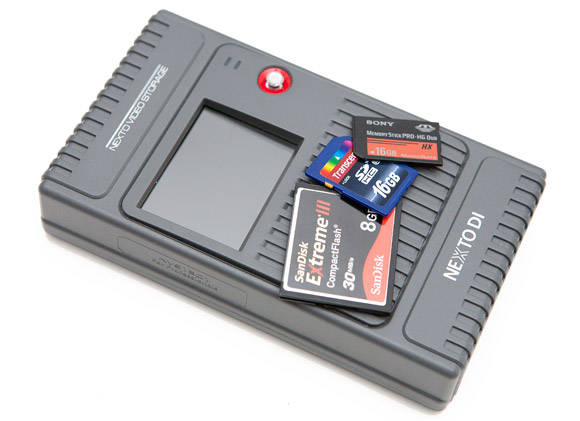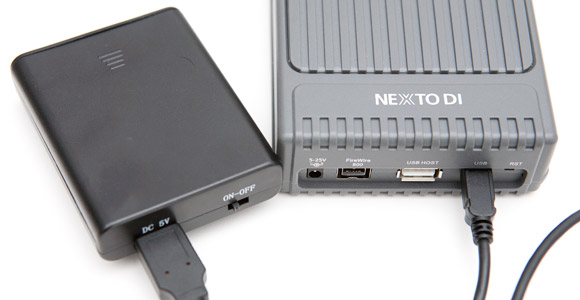Review: NextoDI NVS1501 Backup Device
Posted: December 1st, 2012 | Author: Nathan | Filed under: field recording, gear
The Nexto DI NVS1501 is a burly, professional, and pricey way to back up flash media in the field without a host computer.
[Editorial note: This is an expression of my opinions about this piece of equipment. It was purchased and not provided by the manufacturer. I have no relationship with any company listed below.]
There aren’t many options available for in-the-field, no-computer backups for those of us recording to flash media, like Compact Flash cards, Memory Sticks, and SDHC cards. The most readily-available solutions are usually oriented towards photographers, focusing more on being digital photo albums than professional devices that makes our data more secure, and sometimes only accept JPGs, not arbitrary file types (like, oh, say, .wav files). Some devices, like the Sound Devices 700 series field recorders, will let you write to two pieces of media at once, but what about trips so long that you might need to reclaim CF card space? Or the other devices that we bring with us, like cameras, which can’t do that? Or the majority of trips that I take where carrying a laptop is more hassle or risk than it’s worth?
Enter Nexto DI, a little-known Korean manufacturer of field backup devices oriented towards filmmakers and cinematography digital imaging (DI) technicians. I decided to try the Nexto DI NVS1501 in its 500GB size as a field backup device for four specific pieces of media-capture gear, which could all be in my kit on some trips: the Sound Devices 702 field recorder, the Sony PCM-D50 handheld field recorder, the Canon 7D DSLR, and the GoPro HD Hero 2 POV camera.
 The Basics
The NVS1501 is a field-ready backup device for removable flash-memory media. It’s essentially a hard drive in a ruggedized enclosure, with some interesting firmware, small screen, and options that make it more than just an external hard drive. Mine came with a 500GB 2.5″ laptop hard drive (no speed listed). It’s about the size and weight of the Sony PCM-D50 with batteries installed; all of its shipped components and an extra set of AA’s for its battery sled (see below) will fit perfectly in a Pelican 1120 case or a soft bag that’s in the 7″ x 5″ x 2″ range. The device alone fits snugly into a Pelican 1040 case.

The NVS1501 offers best-in-class connectivity in a solidly-built package.
Its card slots, covered by a rubber door, accommodate most flavors of CF, SD, SDHC, and Memory Stick media, which protrude when inserted. Interconnection is handled by a Firewire 800 port, a standard USB/eSATA port, and a mini USB port. It has an internal, non-removable Lithium-Ion battery that lasts for about 2 hours of copying and takes about 4 hours to recharge from AC power (adapter included). The unit comes with both a DC car adapter and a 4xAA battery sled for recharging. The NVS1501 cannot recharge while on or in use.
The NVS1501 also has an accelerometer, which will disengage the read/write head from the disk if the device is dropped. It also comes with removable rubber bumpers for each end of the device. They are fairly rigid and don’t seem very shock-absorbent, but they’re great for protecting the corners of the case if dropped.
The screen is not just used to show the menu system, but also to preview photos and videos. The screen works poorly for this usage in terms of viewing angle, resolution, and playback speed. But this is an audio/sound blog is it not? Onwards…
In Use
The device is pretty easy to use. Its small LCD screen hosts a menu system controlled by a single 4-way, pressable joystick. One light shows that it’s on or charging, and another shows when the drive is being accessed. That’s about it. But what’s compelling is the variety of ways in which it can be used.
- It can be used as a single-drive backup device.
- You can opt to verify every backup or even pre-scan the drive for bad sectors before writes (of course, each option takes longer than a straight copy)…although these two functions are mutually exclusive.
- With an external USB hard drive, it can back up to both the internal hard drive and the external USB drive at once, effectively cloning every backup you make.
- It can be used as an external hard drive by any MacOS or Windows PC (however, the drive won’t work if formatted for MacOS, and it’s massively overpriced for this purpose).
- It can back up an external USB hard drive to its internal hard drive.
Data transfers are impressive; at least as fast as over my Firewire 800 card reader. I tested various flash memory cards with 3.3 GB of sound effects libraries from The Recordist. Transfer rates generally met or exceeded the cards’ stated speed ratings. I got a range of 33-38 MB per second with modern Compact Flash cards, with SDHC clocking in around 22 MB/s, and Memory Sticks plodding along at 10-12 MB/s. A 2-hour battery life sounds pretty lame until you see how much data can be transferred in a short amount of time, especially with Compact Flash media.

Media in, piece of mind out.
“Multi Copy” is Nexto DI’s phrase for immediate cloning of a card to both the internal drive and an external drive. It works only with USB drives, since using the Firewire port makes the NVS1501 assume it’s connected to a host PC. The device doesn’t output enough juice on the USB bus to power the 2.5″ laptop drives I tried to use with it. That means that AC power is needed: This feels like a “back at the hotel at night” kind of operation. You might see where I’m going with this: I might as well use a laptop with an external drive at that point. If I can’t do dual backups to two drives in the field without AC power, this feature drops significantly in value.
Finally, the NVS1501 is best used with a Firewire 800 connection with a host PC: It provides the fastest connection and enough juice to recharge the device.
On Balance
The single most disappointing part of the unboxing process was seeing the small sticker that indicated that opening the case voids the warranty (which is of the 2-year sort). This device could be even more compelling – lighter, more bombproof, possibly faster – with either an solid state drive (SSD) option, or as a DIY enhancement.
The NVS1501’s price point might be better justified with a user-replaceable battery or even the ability to get juice from a bag-based battery kit like the Remote Audio BDS.  However, on the plus side, it seems that many 5V, 1A charging devices will also recharge the internal battery; one power pack that I used charged the NVS1501 without a hitch. I did not have a chance to test how many recharges I could get off a single set of AA NiMH rechargeable batteries.

A 4xAA battery sled offers non-AC recharging capabilities, but nearly any power pack that can charge an iPhone can recharge the NVS1501.
The Nexto DI NVS1501 is probably the most expensive device of its kind, although it offers thoroughly professional features and is sturdily built. For its feature set, it competes most directly with the HyperDrive COLORSPACE UDMA2. At almost half the price of the NVS1501, it boasts a much larger screen, a user-replaceable hard drive, and a user-replaceable battery. While the Hyperdrive Colorspace UDMA2 lacks robust multi-copy features, bad-sector scanning, anti-shock and anti-drop protection, a Memory Stick port, and appears to have slower copy speeds, it will back up pretty much any arbitrary file type. If these restrictions aren’t dealkillers for you, it’s a lot less expensive and fulfills most of the same workflow and backup roles.
I’d be remiss in mentioning the ultra-cheap Sans Digital MobileSTOR MS1U008. At $150 or so, it’s just a drive enclosure and has pretty limited features, although it will also accept the same media types the NVS1501 does. I’ve never used it, but on paper it looks to be of much lighter-weight buuld quality, online reviews  are tough to come by, and it may be discontinued at the time of this writing.
Other in-the-field, no-computer, no-AC-power options might include Netbooks (cheaper but larger and more prone to failure) and tablets (although making iPads accept non-photo files over the Apple Camera Connection Kit is infamously tricky). One could always just buy a bunch of flash memory cards for a big job or trip…but buying 1 TB of brand-name, UDMA Compact Flash cards would cost over twenty times what a 1TB laptop hard drive would cost. (Granted, the former is non-volatile and lightweight, and the latter is volatile and bulkier.)
Another option for Sound Devices 700-series users would be to get their XL-1394 power conditioner and run an external hard drive right in the bag. Depending on how large you need it to be, that can be a fraction of the cost of the NVS1501, and you gain the benefit of getting a backup while you record. However, that makes it a dedicated device for the field recorder, and my needs happened to be more generalized, and a bare hard drive won’t have the shock resistance, bad-sector-skipping, or even write verifying capabilities the NVS1501 does.
In Summary
On a set or a decent hotel, a DI technician, audio recordist, or photographer will want a full PC and multiple external drives for daily data backups. There are many other data backup options that cost less. The NVS1501 has a lot of features some users don’t need. It’s certainly the most expensive device in its class.
But in the field, in tough conditions, or on long trips without AC power or access to a PC, the Nexto DI NVS1501 is a burly, professional-grade device that does only one thing, and not only does it well, but does it with enough flexibility that it will fit well into nearly any workflow or  level of (healthy) data-redundancy paranoia.
Interesting review – thanks for that. Backup solutions for home/studio is one thing (tricky enough to decide on) but field-use is a whole new ball game.
Decisions, decisions.
while it’s obviously easier to run while recording, you can also backup to an external firewire 400 drive after you’re done recording. it eliminates the cost of the XL-1394 conditioner and is extremely easy to configure with then 700 series menu.
Interesting review–I’d not heard of this product and I appreciate the detailed write-up!